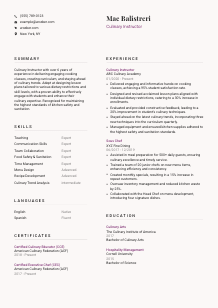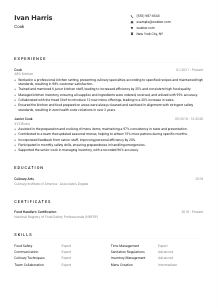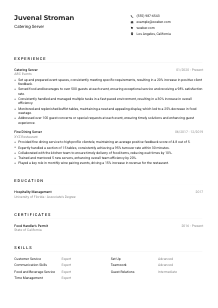Culinary Instructor Resume Example
Whipping up masterful meals, but your resume is not sizzling? Dive into this Culinary Instructor resume example, tailored with Wozber free resume builder. Learn how to blend your gastronomic genius with teaching talent, so your career doesn't just simmer, but reaches a full boil in the job market!

How to write a Culinary Instructor Resume?
Welcome, aspiring Culinary Instructor! You are on a flavorful journey to showcase your culinary expertise and pedagogical prowess through your resume. Crafting an ATS-compliant resume that resonates with the essence of cooking and teaching isn't just about listing ingredients; it's about presenting a gourmet dish that hiring managers can't resist.
With Wozber, you're equipped with a free resume builder, ATS-friendly resume templates, and an ATS resume scanner to ensure your resume not only passes the Applicant Tracking Systems but also captivates the palates of those who wish to hire you. Let's whisk through this step-by-step guide to bake a resume that lands you in the kitchen classroom of your dreams.
Personal Details
Your personal details are the amuse-bouche of your resume, offering a first taste of who you are. Let's make sure it's delightful and invites the hiring manager to indulge further into your application.
1. Your Name, Your Brand
Think of your name as the emblem of your culinary empire. Ensure it's bold and appetizing, set in a clear, easy-to-read font. A chef's hat is recognized universally; your name should be as resplendent on your resume.
2. Job Title as the Main Course
"Culinary Instructor" should be served just below your name, acting as the main course of your introduction. It's essential to mirror the job title from the description, thereby aligning your resume's flavor profile with the appetite of the job.
3. The Essential Condiments
Your contact details are the condiments—essential but not overpowering. Ensure your phone number is fresh (and correct), and your email address is as professional as a chef's jacket. Stick to a format like firstname.lastname@email.com to keep things clean and digestible.
4. Location: The Regional Flavor
"New York, NY" isn't just an address—it's an indication you're already marinated in the local culinary scene, or at least, ready to blend into it. It reassures hiring managers that you're prepared for the role with no added logistics.
5. A Dash of Digital Presence
In today's digital kitchen, a LinkedIn profile or a personal website showcasing your culinary creations can be very enticing. Ensure it's up-to-date and reflects the quality and style of your cooking and teaching philosophy.
Takeaway
Consider your personal details as the opening course of your culinary resume. Make it inviting, accurate, and reflective of the Culinary Instructor role you're aspiring for. This section sets the tone for the rest of your resume journey, so make every detail count!





Experience
Your experience section is where you prove your worth in the culinary world. It's more than just a list; it's a narrative that tells the story of your journey, challenges, and accomplishments. Let's ensure it's as compelling as a Michelin-starred menu.
- Delivered engaging and informative hands‑on cooking classes, achieving a 95% student satisfaction rate.
- Designed and revised acclaimed lesson plans aligned with individual dietary restrictions, catering to a 30% increase in enrollments.
- Evaluated and provided constructive feedback, leading to a 20% improvement in student's culinary techniques.
- Stayed ahead on the latest culinary trends, incorporating three new techniques into the curriculum quarterly.
- Managed equipment and ensured kitchen supplies adhered to the highest safety and sanitation standards.
- Assisted in meal preparation for 500+ daily guests, ensuring culinary excellence and timely service.
- Trained a team of 20 junior chefs on new menu items, enhancing efficiency and consistency.
- Created monthly specials, resulting in a 15% increase in repeat customers.
- Oversaw inventory management and reduced kitchen waste by 25%.
- Collaborated with the Head Chef on menu development, introducing four signature dishes.
1. Decipher the Recipe
Start by analyzing the job description. For a Culinary Instructor role, the focus is on hands-on cooking classes, curriculum development, and a track record in culinary education. Your job is to match this with your past roles.
2. Organize Your Ingredients
Present your experience like a carefully plated dish, with the freshest (most recent) roles upfront. Each position should include the job title, where you cooked up your experience (the company), and the dates the culinary adventure lasted.
3. Describe the Cooking Process
For each role, detail your recipes for success. Highlight how you've created engaging lesson plans, improved student skills, or maybe even redesigned a culinary curriculum. Use action verbs to bring your culinary story to life.
4. Sprinkle in Quantifiable Achievements
Metrics are the seasoning of your experience section. Maybe you increased student enrollment by 30% or improved satisfaction rates. Quantifying your achievements adds depth and flavor, making your accomplishments more tangible.
5. Trim the Fat
Stay focused on your culinary and teaching journey. While it might be tempting to include your entire professional menu, limit the details to those most relevant to a Culinary Instructor role. Keep your resume lean and flavorful.
Takeaway
Let your experience section tell a mouth-watering story of culinary excellence and educational innovation. This is your chance to show potential employers the unique blend of skills and experiences that make you the perfect candidate. Make it robust, relevant, and, above all, deliciously tailored to the Culinary Instructor role.
Education
Much like a well-stocked pantry is essential for any chef, a solid educational background lays the foundation for your culinary instruction career. It's not just about where you've studied; it's about showcasing your commitment to the craft.
1. Select the Prime Cuts
While our example didn't specify explicit educational needs, it's important to list any culinary or hospitality degrees prominently. They immediately show you've got the foundational knowledge to back up your skills.
2. Presentation is Key
Arrange your educational credentials as you would ingredients on a kitchen shelf: cleanly and clearly. Include the degree, the institution, and the year polished off, in that order. Presentation matters in both kitchens and resumes.
3. Match the Menu
If the role specifically asks for a 'Bachelor of Culinary Arts', make sure to highlight that degree first and foremost. Ensure your education reflects the job's requirements like a well-crafted menu matches the restaurant's concept.
4. Special Ingredients
For roles that blend culinary skills with education, consider highlighting relevant coursework or workshops you've led or contributed to. This specificity can make a significant difference, showing you're prepared to teach and inspire.
5. Additional Garnishes
Honors, awards, or membership in culinary associations can be the cherry on top. Especially for early-career chefs, these extras can help your resume stand out like a signature dish in a crowded menu.
Takeaway
Your education section is your chance to showcase the solid base of knowledge you'll bring to the teaching kitchen. Make it clear, concise, and relevant, highlighting how your background prepares you uniquely for the Culinary Instructor role. Let it underscore your readiness to educate the next generation of culinary artisans.
Certificates
In the culinary world, certificates are like the secret spices that can elevate a dish from good to unforgettable. They offer concrete proof of your skills and continuous learning dedication. Let's make sure they add just the right touch to your resume.
1. Identify the Key Ingredients
Review the job description again; it asked for recognized culinary certifications like Certified Culinary Educator (CCE) or Certified Executive Chef (CEC). These are your hero ingredients, so make sure they're prominently featured.
2. Selection of Certificates
Choose to display certificates that directly correlate with the job's flavor profile. It's about quality, not quantity. A well-chosen certification can significantly strengthen your position as a suitable candidate.
3. Freshness Matters
Dates can signal the freshness of your culinary credentials. If your certificates have expiration dates or are particularly recent, include these details. It shows you're keeping your skills sharp and up-to-date.
4. Hungry for More
The culinary field is ever-evolving, and so should your education. Emphasize your commitment to ongoing learning and staying abreast of the latest culinary trends and techniques. It shows you're not just keeping up—you're leading the pack.
Takeaway
Like the perfect seasoning, your certificates can greatly enhance your resume, setting you apart from other candidates. They add depth to your culinary narrative, underscoring your expertise and commitment to excellence in culinary education. Let them shine!
Skills
Skills in the Culinary Instructor resume are like the chef's knife—versatile, essential, and indicative of your expertise. A well-honed skills section can make a significant difference in cutting through the competitive job market.
1. Sharpen Your Blade
Start by finely chopping the job description to identify both hard and soft skills. Skills like lesson planning, dietary restriction tailoring, and kitchen management are all part of the cuisine you'll need to master.
2. Curate Your Culinary Toolkit
Your resume should reflect a balanced mix of hard and soft skills. Highlight those that align with the Culinary Instructor role—teaching, communication, recipe development, and trend analysis are all ingredients for success.
3. Neatly Arrange on the Board
Resist the temptation to clutter your skills section with every utensil in the kitchen. Instead, focus on those most relevant to the role, ensuring each one is a testament to your capability and enhances your profile.
Takeaway
Approach the skills section with precision and care, presenting a curated selection that showcases your prowess in both culinary arts and education. Let it reflect the depth of your expertise and your readiness to lead in the kitchen classroom.
Languages
In the diverse and multicultural world of culinary arts, language skills can add an extra layer of richness to your resume. From conversing with international students to understanding global culinary trends, languages can be invaluable.
1. Review the Menu
The job description highlighted "English language skills are a core requirement." Make sure to list English first and denote your proficiency level, whether it's native, fluent, or conversational.
2. Add a Side of Languages
Even if the job description doesn't specifically call for additional languages, having them can be a plus. They demonstrate your ability to engage with diverse culinary traditions and students from various backgrounds.
3. Honest Portion Sizes
Accuracy in portraying your language proficiency is key. Overestimating your fluency can lead to embarrassing situations, while underestimating it sells you short. Be precise and honest.
4. The Palette of a Global Chef
Even if teaching will predominately be in English, showcasing additional languages can illustrate your capability to connect with international cuisines, trends, and students, enriching the learning experience for all.
5. Taste the World
For a Culinary Instructor, understanding the language of food is as important as spoken languages. Highlighting your linguistic abilities can show you're not just teaching recipes—you're teaching a global culinary dialogue.
Takeaway
Your language skills are a testament to your ability to navigate the diverse world of culinary arts. They enrich your profile, showing you as a well-rounded and culturally competent educator. Flaunt them as you would a signature dish, ready to share with the world.
Summary
A well-crafted summary is like the icing on a cake—it brings everything together and leaves a lasting impression. Here, you encapsulate your culinary journey, your teaching philosophy, and the unique flavors you bring to the table.
1. Mix the Ingredients
Start by blending your professional identity with your achievements. Mention your total years of experience and combine this with your culinary and educational expertise, as seen in the example resume.
2. Add Flavor with Skills
Sprinkle in a few of your most relevant skills, ensuring they cater to the job description. Whether it's curriculum design or allergy-friendly cooking, let them know you have the specific tastes they're craving.
3. Keep It Light and Airy
While it's tempting to add every accolade and skill, remember that a summary should be digestible. Aim for 3-5 lines that invite the reader to learn more about you, much like a well-composed appetizer.
4. Presentation Matters
Ensure your summary looks appealing on the page. Just as you'd plate a dish to impress, format your summary to catch the eye. Use spacing and bullet points to make it easy to read and engaging.
Takeaway
Your summary is the taste test that either entices hiring managers to dive deeper or move on. Craft it with care, highlighting your unique value proposition as a Culinary Instructor. Make it irresistible, reflecting the depth of your experience and the breadth of your talents.
Bon Appétit on Your Culinary Instructor Journey
With these detailed steps, you're well on your way to crafting a resume that not only passes the ATS but also impresses any hiring manager. Your resume is your menu, enticing schools and culinary programs to choose you as their Culinary Instructor. Use Wozber's free resume builder, leverage ATS-friendly resume templates, and scan your resume with the ATS resume scanner for the perfect finish. Bon appétit, chef! Your next great culinary teaching adventure awaits.

- Minimum of 5 years culinary experience in a professional kitchen.
- Proven track record of teaching culinary classes or workshops.
- Possession of a recognized culinary certification (e.g., Certified Culinary Educator (CCE), Certified Executive Chef (CEC)).
- Strong interpersonal and communication skills to effectively engage with individuals and groups.
- Demonstrated ability to develop curriculum and lesson plans tailored to various skill levels and dietary restrictions.
- English language skills are a core requirement.
- Residence in or willingness to relocate to New York, NY.
- Deliver engaging and informative hands-on cooking classes to students of varying skill levels.
- Design and revise lesson plans, ensuring they align with the needs and preferences of the student body.
- Evaluate and provide constructive feedback to students on their culinary techniques and dishes.
- Stay updated on the latest culinary trends, techniques, and industry best practices to ensure the curriculum remains relevant and up-to-date.
- Manage equipment and kitchen supplies, adhering to safety and sanitation standards.















